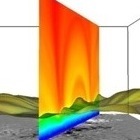
|
Coronal Dynamics
|
 |

|
Coronal Dynamics
|
 |
 Cool stars like our Sun are surrounded by a million Kelvin hot outer atmosphere, the corona. It is still puzzling what sustains its high temperature, being 100 to 1000 times hotter than the stellar surface. Being related to (changes of) the magnetic field, we can expect the heating mechanism to change the structure of the corona, to drive plasma flows, and to induce wave phenomena. On the Sun we can observe this dynamic evolution of the corona in detail, especially through spectroscopy and imaging at extreme ultraviolet and X-ray wavelengths.
Cool stars like our Sun are surrounded by a million Kelvin hot outer atmosphere, the corona. It is still puzzling what sustains its high temperature, being 100 to 1000 times hotter than the stellar surface. Being related to (changes of) the magnetic field, we can expect the heating mechanism to change the structure of the corona, to drive plasma flows, and to induce wave phenomena. On the Sun we can observe this dynamic evolution of the corona in detail, especially through spectroscopy and imaging at extreme ultraviolet and X-ray wavelengths.
In our group we employ magneto-hydrodynamics (MHD) models including the synthesis of coronal emission. Numerical experiments in 1D, 2D and 3D allow us to directly compare the emission of the synthetic corona to real observations. This aims at understanding the distribution of the heating rate in space and time to understand which coronal heating mechanism(s) produce the hot corona and drive its sometimes violent dynamics.
|
Science Objectives |
|
|
Group members |
|
|
Coronal Dynamics home page |
The problem of coronal heating is considered one of the most interesting problems in stellar astrophysics. Using advanced numerical experiments including the synthesis of coronal emission allows us to study the processes heating the corona and driving its dynamics.
To reach these science goals we employ and further develop different different numerical codes to solve the MHD equations, mostly the ![]() Pencil Code and
Pencil Code and ![]() MPI-AMRVAC. The coronal emission that can be expected from the models we synthesize the
MPI-AMRVAC. The coronal emission that can be expected from the models we synthesize the ![]() CHIANTI atomic data base. We compare these model results to solar observations with, e.g., the
CHIANTI atomic data base. We compare these model results to solar observations with, e.g., the ![]() SUMER EUV spectrograph on SOHO, the Extreme ultraviolet Imaging Spectrometer
SUMER EUV spectrograph on SOHO, the Extreme ultraviolet Imaging Spectrometer ![]() EIS on Hinode and the Atmospheric Imaging Assembly
EIS on Hinode and the Atmospheric Imaging Assembly ![]() AIA on SDO.
AIA on SDO.
| Group leader |
Hardi Peter |
| Postdocs |
Sven Bingert Tayeb Aiouaz |
| PhD students |
Philippe Bourdin Tijmen van Wettum |
| © 2009, Max Planck Institute for Solar System Research, Lindau |
Dr. Hardi Peter 10-05-2011 |